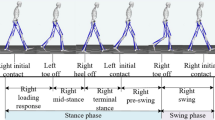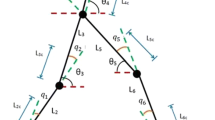Abstract
An interval type-2 fuzzy weighted support vector machine (IT2FW-SVM) is proposed to address the problem of high energy consumption for biped walking robots. Different from the traditional machine learning method of ‘copy learning’, the proposed IT2FW-SVM obtains lower energy cost and larger zero moment point (ZMP) stability margin using a novel strategy of ‘selective learning’, which is similar to human selections based on experience. To handle the uncertainty of the experience, the learning weights in the IT2FW-SVM are deduced using an interval type-2 fuzzy logic system (IT2FLS), which is an extension of the previous weighted SVM. Simulation studies show that the existing biped walking which generates the original walking samples is improved remarkably in terms of both energy efficiency and biped dynamic balance using the proposed IT2FW-SVM.




Similar content being viewed by others
Explore related subjects
Discover the latest articles, news and stories from top researchers in related subjects.References
Dariush B, Gienger M, Arumbakkam A et al (2009) Online transfer of human motion to humanoids. Int J Humanoid Robot 6(2):265–289
McGeer T (1990) Passive dynamic walking. Int J Robot Res 9(2):62–82
Collins S, Ruina A, Tedrake R, Wisse M (2005) Efficient bipedal robots based on passive dynamic walkers. Science 307(5712):1082–1085
Goswami D, Vadakkepat P (2009) Planar bipedal jumping gaits with stable landing. IEEE Trans Robot 25(5):1030–1046
Rajendra R, Pratihar DK (2011) Multi-objective optimization in gait planning of biped robot using genetic algorithm and particle swarm optimization tool. J Control Eng Technol 1(2):81–94
Vundavilli PR, Pratihar DK (2010) Dynamically balanced optimal gaits of a ditch-crossing biped robot. Robot Auton Syst 58(4):349–361
Vundavilli PR, Pratihar DK (2011) Near-optimal gait generations of a two-legged robot on rough terrains using soft computing. Robot Comput-Integr Manuf 27(3):521–530
Vahedian A, Yazdi MS, Effati S, Yazdi HS (2011) Fuzzy cost support vector regression on the fuzzy samples. Appl Intell 35(3):428–435
Chatterjee S (2013) Vision-based rock-type classification of limestone using multi-class support vector machine. Appl Intell 39(1):14–27
Lee LH, Wan CH, Rajkumar R, Isa D (2012) An enhanced support vector machine classification framework by using Euclidean distance function for text document categorization. Appl Intell 37(1):80–99
Lee LH, Rajkumar R, Isa D (2012) Automatic folder allocation system using Bayesian-support vector machines hybrid classification approach. Appl Intell 36(2):295–307
Shao YH, Wang Z, Chen WJ, Deng NY (2013) Least squares twin parametric-margin support vector machine for classification. Appl Intell. doi:10.1007/S10489-013-0423-y
Wang CW, You WH (2013) Boosting-SVM: effective learning with reduced data dimension. Appl Intell. doi:10.1007/S10489-013-0423-9
Ferreira JP, Crisostomo MM, Coimbra AP (2009) SVR versus neural-fuzzy network controllers for the sagittal balance of a biped robot. IEEE Trans Neural Netw 20(12):1885–1897
Ferreira JP, Crisostomo MM, Coimbra AP (2011) Sagittal stability PD controllers for a biped robot using a neurofuzzy network and an SVR. Robotica 29(5):717–731
Kim DW, Seo SJ, de Silva CW et al (2009) Use of support vector regression in stable trajectory generation for walking humanoid robots. ETRI J 31(5):565–575
Suykens JAK, De Brabanter J, Lukas L, Vandewalle J (2002) Weighted least squares support vector machines: robustness and sparse approximation. Neurocomputing 48(1–4):85–105
Kramer KA, Hall LO, Goldgof DB, Remsen A, Luo T (2009) Fast support vector machines for continuous data. IEEE Trans Syst Man Cybern, Part B, Cybern 39(4):989–1001
Guo L, Wu Y, Zhao L, Cao T, Yan W, Shen X (2011) Classification of mental task from EEG signals using immune feature weighted support vector machines. IEEE Trans Magn 47(5):866–869
Tao Q, Wu GW, Wang FY, Wang J (2005) Posterior probability support vector machines for unbalanced data. IEEE Trans Neural Netw 16(6):1561–1573
Elattar EE, Goulermas J, Wu QH (2010) Electric load forecasting based on locally weighted support vector regression. IEEE Trans Syst Man Cybern, Part C, Appl Rev 40(4):438–447
Qi B, Zhao C, Youn E (2011) Use of weighting algorithms to improve traditional support vector machine based classifications of reflectance data. Opt Express 19(27):26816–26826
Chuang CC (2007) Fuzzy weighted support vector regression with a fuzzy partition. IEEE Trans Syst Man Cybern, Part B, Cybern 37(3):630–640
Emre C, Kemal P, Salih G (2007) A new medical decision making system: least square support vector machine (LSSVM) with fuzzy weighting pre-processing. Expert Syst Appl 32(2):409–414
Hao PY (2008) Fuzzy one-class support vector machines. Fuzzy Sets Syst 159(18):2317–2336
Zhang Y, Liu XD, Xie FD (2009) Fault classifier of rotating machinery based on weighted support vector data description. Expert Syst Appl 36(4):7928–7932
Tayal DK, Saxena PC, Sharma A, Khanna G, Gupta S (2013) New method for solving reviewer assignment problem using type-2 fuzzy sets and fuzzy functions. Appl Intell. doi:10.1007/S10489-013-0445-5
Jafarzadeh S, Fadali MS, Sonbol AH (2011) Stability analysis and control of discrete type-1 and type-2 TSK fuzzy systems: Part II. Control design. IEEE Trans Fuzzy Syst 19(6):1001–1013
Khanesar MA, Kayacan E, Teshnehlab M (2011) Analysis of the noise reduction property of type-2 fuzzy logic systems using a novel type-2 membership function. IEEE Trans Syst Man Cybern, Part B, Cybern 41(5):1395–1406
Tao CW, Taur J, Chuang CC (2011) An approximation of interval type-2 fuzzy controllers using fuzzy ratio switching type-1 fuzzy controllers. IEEE Trans Syst Man Cybern, Part B, Cybern 41(3):828–839
Barkat S, Tlemcani A, Nouri H (2011) Noninteracting adaptive control of PMSM using interval type-2 fuzzy logic systems. IEEE Trans Fuzzy Syst 19(5):925–936
Biglarbegian M, Melek WW, Mendel JM (2010) On the stability of interval type-2 TSK fuzzy logic control systems. IEEE Trans Syst Man Cybern, Part B, Cybern 40(3):798–818
Zhang D (2012) A new approach and system for attentive mobile learning based on seamless migration. Appl Intell 36(1):75–89
Zajaczkowski J, Verma B (2012) Selection and impact of different topologies in multi-layered hierarchical fuzzy systems. Appl Intell 36(3):564–584
Xu C, Wang Y, Gu Y, Lin S, Yu G (2012) Efficient fuzzy ranking queries in uncertain databases. Appl Intell 37(1):47–59
Chevallereau C, Aoustin Y (2001) Optimal reference trajectories for walking and running of a biped robot. Robotica 19:557–569
Sardain P, Bessonnet G (2004) Forces acting on a biped robot. Center of pressure—zero moment point. IEEE Trans Syst Man Cybern, Part A, Syst Hum 34(5):630–637
Tan KK, Wang Q-G, Hang CC (1999) Advances in PID control. Springer, London
Liu Z, Zhang Y, Wang YN (2007) A type-2 fuzzy switching control system for biped robots. IEEE Trans Syst Man Cybern, Part C, Appl Rev 37(6):1202–1213
Liang QL, Mendel JM (2000) Interval type-2 fuzzy logic systems: theory and design. IEEE Trans Fuzzy Syst 8(5):535–550
Juang C-F, Hsu C-H (2009) Reinforcement interval type-2 fuzzy controller design by online rule generation and q-value-aided ant colony optimization. IEEE Trans Syst Man Cybern, Part B, Cybern 39(6):1528–1542
Wang L, Liu Z, Chen CLP, Zhang Y, Lee S, Chen X (2013) A UKF-based predictable SVR learning controller for biped walking. IEEE Trans Syst Man Cybern, Part A, Syst Hum. doi:10.1109/TSMC.2013.2242887
Ortiz-García EG, Salcedo-Sanz S, Pérez-Bellido ÁM, Portilla-Figueras JA (2009) Improving the training time of support vector regression algorithms through novel hyper-parameters search space reductions. Neurocomputing 72(16–18):3683–3691
Acknowledgements
This work was supported by the National Natural Science Foundation of China under Projects 60974047 and U1134004, by the Natural Science Foundation of Guangdong Province under Grant S2012010008967, by the Science Fund for Distinguished Young Scholars (S20120011437), by the 2011 Zhujiang New Star, by the FOK Ying Tung Education Foundation of China under Grant 121061, by the Ministry of Education of New Century Excellent Talent, by the 973 Program of China under Grant 2011CB013104, and by the Doctoral Fund of Ministry of Education of China under Grant 20124420130001.
Author information
Authors and Affiliations
Corresponding author
Rights and permissions
About this article
Cite this article
Wang, L., Liu, Z., Chen, C.L.P. et al. Interval type-2 fuzzy weighted support vector machine learning for energy efficient biped walking. Appl Intell 40, 453–463 (2014). https://doi.org/10.1007/s10489-013-0472-2
Published:
Issue Date:
DOI: https://doi.org/10.1007/s10489-013-0472-2




